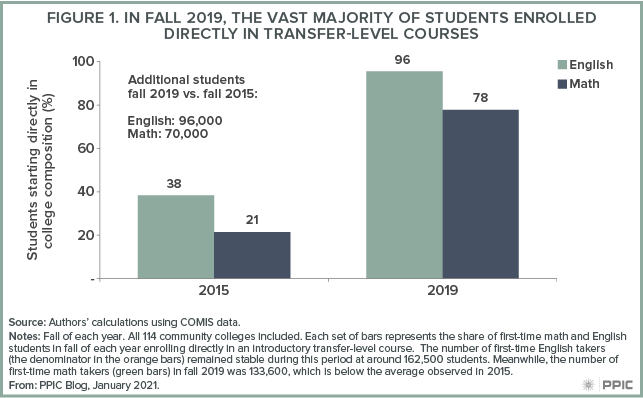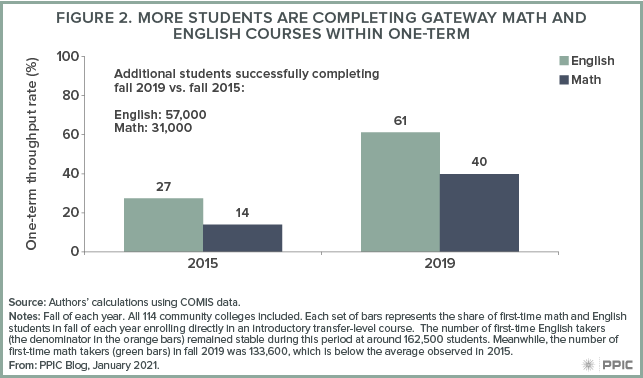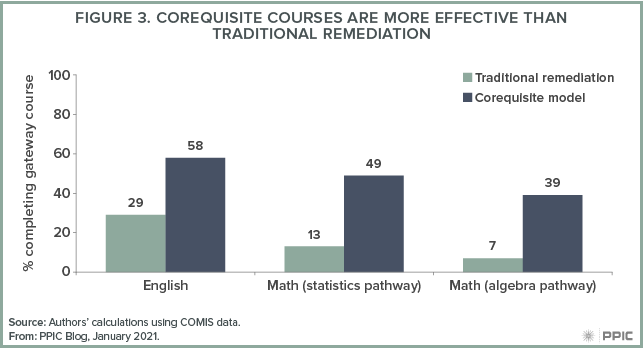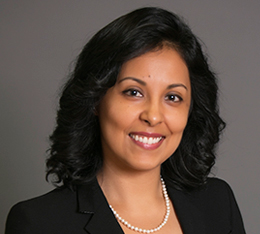Olga Rodriguez, research fellow at the Public Policy Institute of California, presented research at the California Community Colleges Board of Governors Meeting on January 19, 2021. Her prepared remarks are below.
Background
AB 705 mandates that California Community Colleges (CCCs) maximize the probability that a student will enter and complete transfer-level English and math courses within one year, and that colleges use high school records, such as GPA and prior coursework, as the primary criteria for placement. In the past, community colleges often placed students in remedial courses based on placement tests, and most students dropped out. New research now questions the validity of placement tests and shows that high school records better predict success.
In the wake of community colleges adopting AB 705, our research finds that shares of students starting in transfer-level courses quadrupled between 2015 and 2019, with rates of course completion doubling and tripling. This progress is outstanding, but inequities still linger across the system—while the policy has narrowed enrollment gaps and course completion gaps between white students and Latino and African American students, notable gaps remain at some colleges. However, the many colleges offering corequisite remedial support have made it more likely that students succeed in transfer-level courses, efforts that have also helped shrink racial and ethnic gaps.
Prepared remarks
Our recent report, A New Era of Student Access at California’s Community Colleges, aims to shed light on how AB 705 affected student access, outcomes, and racial equity by specifically looking at fall 2019, the deadline for implementing AB 705. We draw on three main data sources, including 1) student-level longitudinal data provided by the Chancellor’s Office, 2) a comprehensive scan of colleges’ documents and websites and 3) interviews with college faculty, staff, and administrators.
To begin, we examined data for all 114 colleges in the California Community College system to determine how access to transfer-level math and English changed over time. Enrollment is our measure of access because it is a direct consequence of colleges’ placement methods.
Figure 1 illustrates how a few years ago, hundreds of thousands of students were not accessing gateway math and English courses. Then in fall 2019, the share of first-time math students who began in a transfer-level math course more than doubled in one year and nearly quadrupled compared to 2015. In English, access to college composition is now nearly universal—with 96% of first-time English students taking college composition as their first English course, compared to just over a third in 2015.

Next, when we examined how the policy change affected equity, we found that the CCC system has made remarkable progress toward eradicating long-standing racial and ethnic inequities in access to transfer-level courses, nearly eliminating the gaps in English and narrowing them significantly in math.
I want to highlight that this is outstanding systemwide progress within a few years. But these state averages hide important institutional variation. Particularly when examining proportionality index by college, we find that systemwide numbers often mask variation across the system. (The proportionality index indicates whether a subgroup of students is represented equitably among those starting in transfer-level courses relative to representation among all first-time students in the discipline—that is, if 30% of first-time math students are African American, we want to see 30% of students starting in transfer-level math to be African American.)
Notably, the inequities in representation for English are gone for Latino students and remain at only 1% of colleges for African Americans. However, in math, 17% of colleges still show significant underrepresentation of African Americans among first-time math students who start directly in a transfer-level math course. But this percentage represents a dramatic improvement from 2015, when 79% of colleges were below equity. For Latinos, in fall 2019, at 4% of colleges Latinos were underrepresented in transfer-level math with respect to their share of the population, compared to 69% in 2015.
The way colleges structure their placement policies and course sequences may contribute to higher enrollment in remedial courses and lingering inequities. For example, higher remediation rates and inequities are more likely when colleges: 1) use stricter placement rules, such as higher GPA thresholds; 2) require remediation versus making it optional; 3) use counselors to gather multiple measures data instead of automating the placement process, and 4) use sample reading/writing/math problems as part of a Guided Self-Placement process.
While the data suggest some work is still needed to improve equitable access to transfer-level courses, this subset of colleges—which in 2019 had among the highest remediation rates—are successes compared to the old regime. Indeed, 2019 remediation rates at these colleges are 2–3 times lower than the 2015 state average. These data also suggest that post-AB 705, continuing efforts can target this subset of colleges and the specific discipline where significant inequities persist.
Access to the transfer-level courses, however, is only half of the story. Given the scale of the change we are seeing, it is also vital to examine course outcomes after students enroll in the course. For this, we examined math and English throughput rates: the proportion of first-time math/English students who successfully complete a transfer-level course with a grade of C or better. Here, one-term throughput rates increased significantly in fall 2019.

In English, successful completions of college composition more than doubled between 2015 and 2019. That is, over 57,000 more students completed college composition in fall 2019 compared to fall 2015. In math, almost three times more students—over 31,000 more students—completed a transfer-level course compared to fall 2015. These successful completions provide descriptive evidence that restricting access to transfer-level gateway courses prior to AB 705 suppressed student outcomes.
Notably, when we disaggregate the throughput data by race/ethnicity, we find that rates for Latino and African American students were three to four times higher in fall 2019 compared to fall 2015; however, racial/ethnic gaps have not gone away. In fact, the proportionality index for successful completions shows that, across the system at over half of colleges enrolling more than 20 African American students, African Americans remain underrepresented in successful completions of math and English. Latinos also continue to be underrepresented in course completions, but to a lesser extent.
Taken together, the data is telling us that many more students are starting directly in transfer-level courses, and many more students are successfully completing courses. But it is also painfully clear that the students who struggle in this new policy landscape are more visible than ever. In fact, another important outcome of AB 705 is that faculty, staff, and administrators are now asking about this group of students. Under the old system, the group of students who did not make it into and through the gateway math and English courses often slipped away unnoticed.
At this point, the question becomes what do faculty, staff, and administrators need to do to help ensure this group of students succeeds. We have found that there is often a group who interrogates classroom and campus policies and practices, to examine whether they are supporting or hindering students’ success. There is also a group who believes this group of students actually did need traditional remediation.
Our research finds that traditional remediation is not necessarily the answer. One way colleges across the system have stepped up to support students is by providing corequisite remedial support, where students receive additional academic support while enrolled in the transfer-level course. Figure 3 shows that students in corequisite models are much more likely to complete a transfer-level course in one term than students who start in traditional remediation and are given two terms or one year in English and up to three terms or (fall-to-fall) in the statistics and algebra math pathways.

Also, compared to the standard college composition courses, corequisite models had a higher share of Latino and African American students—and they are more equitably represented in successful completions. The same is true in statistics and liberal arts math (SLAM) but more work is needed to ensure equitable representation among successful completions for the algebra-based pathway (known as BSTEM or business, science, technology, engineering, and math).
And as with our previous findings, the corequisite throughput data reveals sizable progress across racial/ethnic groups, but more work is necessary to eliminate racial equity gaps. Still, I cannot emphasize enough how impressive these gains are. Throughput rates are two to five times higher in corequisite courses, which tells us that future efforts should focus on ensuring corequisite courses are designed and taught with equity in mind.
To conclude, we provide a set of recommendations derived from the research to help inform discussions on how to advance student success and equity post-AB 705.
First, given that placement is a high-stakes decision, we recommend that the subset of colleges continuing to experience inequitable access closely examine and amend their placement policies; this is especially important in math. Our findings also suggest that colleges could do more to increase corequisite offerings to ensure that everyone who could benefit from corequisites is able to access them.
Second, moving forward, administrators, faculty, counselors, and researchers will need to work together to identify what is driving the persistent gaps in successful completions and find ways to address them. The time is ripe for this work, as the pandemic and the racial justice movement signal a genuine interest in examining how bias and structural inequities affect student outcomes. Additionally, with more students enrolling directly into gateway courses, colleges will need to find new ways to support students with diverse backgrounds and varying levels of academic preparation. Faculty, counselors, and advisors will need to play a proactive role connecting students with academic and nonacademic student supports, such as tutoring, food pantries, and mental health services—all of which are becoming more prominent with the COVID-19 pandemic.
Finally, the dramatic changes brought on by AB 705 give colleges an opportunity to reimagine and improve students’ early college experiences with equity in mind. With initiatives like the Vision for Success and Guided Pathways also being implemented at colleges across the state, this provides an especially powerful opportunity to ensure alignment across different initiatives to ensure that students have the opportunities and supports they need to succeed in college and beyond.




